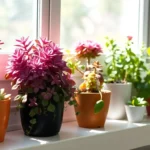Discover the intriguing area of cacti – these remarkable desert survivors have captured hearts worldwide with their unique beauty and incredible resilience. From tiny barrel cacti that fit in your palm to towering saguaros reaching 40 feet high, we’re about to explore the diverse universe of cactus plants that’ll transform how you think about these spiky wonders.
We’ve all seen the classic prickly pear at garden centers, but did you know there are over 2,000 cactus species thriving across the globe? Each type brings its own personality – some bloom with vibrant flowers, others showcase stunning geometric patterns, and many require surprisingly little care to flourish in your home.
Whether you’re a seasoned plant parent or just starting your green journey, understanding different cactus varieties opens doors to low-maintenance gardening success. We’ll guide you through the most popular and unique types, helping you choose the perfect cacti companions for your space and lifestyle.
Desert Cacti: The Classic Spiny Survivors
Desert cacti represent the quintessential image most people have when they think of these remarkable plants. These hardy survivors have evolved incredible adaptations to thrive in some of Earth’s harshest environments.
Barrel Cactus Varieties
Barrel cacti earn their name from their distinctive rounded, cylindrical shape that resembles old-fashioned water barrels. We find these robust desert dwellers throughout the southwestern United States and northwestern Mexico, where they serve as living water reservoirs during extended drought periods.
Golden Barrel Cactus (Echinocactus grusonii) stands as the most recognizable barrel variety, featuring bright yellow spines arranged in geometric patterns across its spherical body. This slow-growing specimen can reach up to 3 feet in diameter and lives for over 100 years in optimal conditions.
Fishhook Barrel Cactus (Ferocactus wislizeni) displays curved central spines that resemble fishing hooks, giving this species its memorable name. We observe these cacti producing vibrant yellow, orange, or red flowers that crown their tops during late summer blooming seasons.
Compass Barrel Cactus (Ferocactus cylindraceus) leans toward the south in its natural habitat, historically helping desert travelers navigate their direction. This unique growth pattern occurs as the plant seeks optimal sun exposure while protecting its growing tip from intense midday heat.
Prickly Pear Species
Prickly pear cacti distinguish themselves through their flat, paddle-shaped segments called cladodes that stack upon each other to create sprawling colonies. We encounter over 200 species of prickly pears across diverse habitats, from desert floors to coastal regions.
Eastern Prickly Pear (Opuntia humifusa) surprises many gardeners as the most cold-hardy cactus species, surviving temperatures as low as -20°F in northern climates. This adaptable variety produces bright yellow flowers followed by edible purple fruits that wildlife and humans have harvested for centuries.
Beavertail Prickly Pear (Opuntia basilaris) showcases smooth, bluish-green pads without traditional spines, instead featuring clusters of small barbed bristles called glochids. We admire its stunning magenta flowers that bloom profusely in spring, creating dramatic desert displays.
Indian Fig Prickly Pear (Opuntia ficus-indica) serves dual purposes as both ornamental plant and food source, with its large pads and fruits commonly used in Mexican and Mediterranean cuisines. This species can grow up to 16 feet tall and produces sweet, juicy fruits known as tunas.
Cholla Cactus Types
Cholla cacti create some of the most formidable desert landscapes with their branching, tree-like structures covered in dense spine clusters. We observe these “jumping cacti” throughout the Sonoran Desert, where their detached segments easily attach to passing animals and humans for seed dispersal.
Teddy Bear Cholla (Cylindropuntia bigelovii) appears deceptively cuddly from a distance due to its dense golden spines that create a fuzzy appearance. This compact species grows 3-5 feet tall and produces chains of cylindrical segments that drop readily when disturbed.
Staghorn Cholla (Cylindropuntia versicolor) develops impressive branching patterns that resemble deer antlers, creating sculptural desert specimens up to 8 feet tall. We notice its purple-tinged joints and magenta flowers that bloom from April through June, attracting desert pollinators.
Chain Fruit Cholla (Cylindropuntia fulgida) produces remarkable chains of fruit that can persist for years without falling, creating unusual hanging clusters along its branches. This species reaches heights of 12 feet and forms dense thickets that provide crucial habitat for desert wildlife like pack rats and cactus wrens.
Forest Cacti: The Unexpected Tropical Types
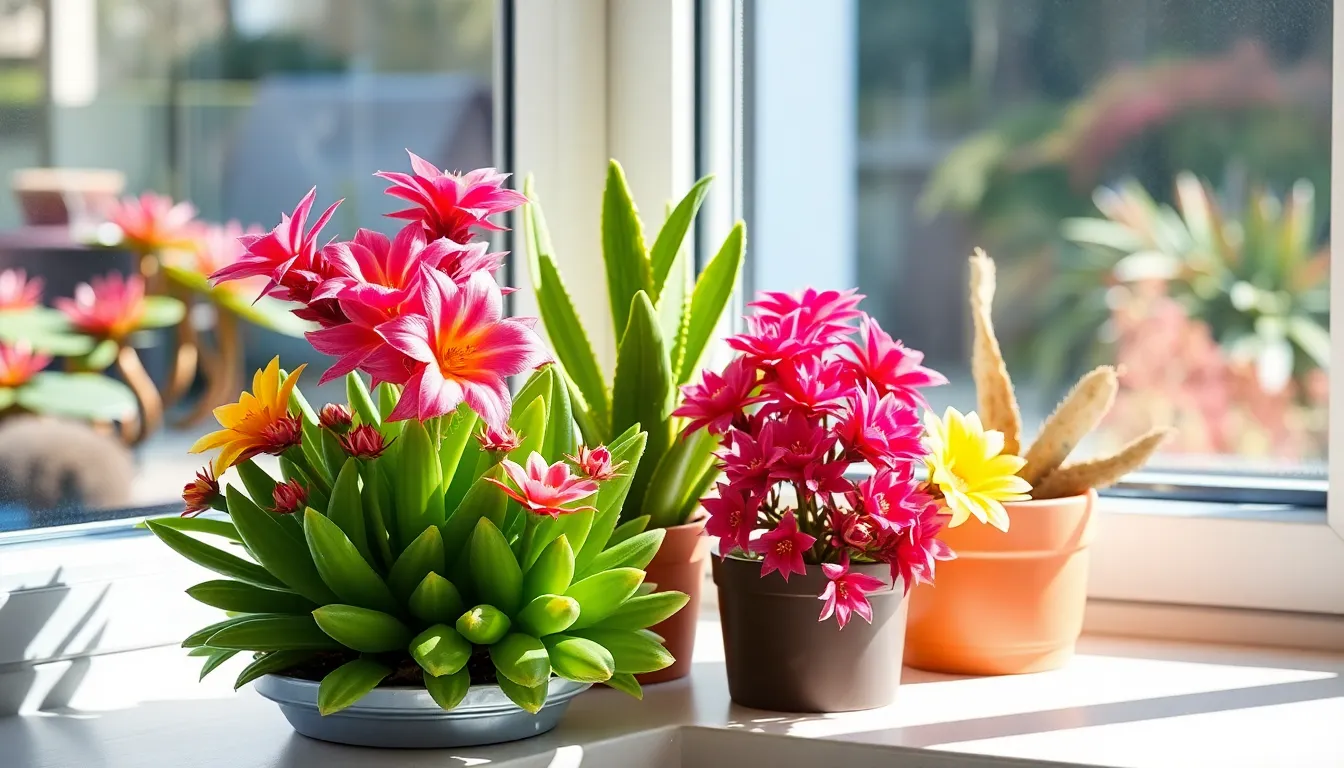
Moving beyond the desert landscapes we’ve explored, forest cacti represent an entirely different category that thrives in humid, tropical environments. These epiphytic species grow naturally on tree branches in rainforests rather than sandy desert floors, creating a stunning contrast to their desert cousins.
Christmas Cactus and Holiday Varieties
Christmas Cactus species from the Schlumbergera genus bring vibrant color to our homes during winter months. We’ve found these Brazilian rainforest natives produce bright red, pink, or white flowers that bloom around the holiday season, making them popular houseplants in cooler climates.
Related varieties include the Thanksgiving Cactus and Easter Cactus, each blooming at different times throughout the year. These holiday cacti share similar care requirements but display slightly different flower shapes and blooming schedules. Their flattened, leaf like stems distinguish them from traditional spiny desert varieties.
Easter Cactus Species
Easter Cactus (Hatiora gaertneri) stands out among tropical species with its distinctive sharply pointed edges on leaf like stems. We notice this variety typically produces star shaped flowers during spring months, creating beautiful displays when other cacti remain dormant.
Form similarities to Christmas Cactus make identification challenging for beginners, but the pointed stem segments and spring blooming pattern help distinguish this species. Native to Brazilian forests, Easter Cactus requires similar humid conditions and indirect lighting to thrive indoors.
Epiphyllum and Night-Blooming Cereus
Epiphyllum species showcase some of the most spectacular flowers in the cactus family with their large, colorful blooms on flat, broad stems. We’ve observed these orchid cacti producing flowers that can measure several inches across, often in vibrant pinks, whites, and yellows.
Night-Blooming Cereus refers to several species in Selenicereus and Peniocereus genera that create magical nighttime displays with their fragrant, spectacular flowers. These nocturnal bloomers open only at night, often lasting just one evening before closing permanently. Both types prefer tropical forest conditions with high humidity and filtered light, making them excellent choices for indoor cultivation in temperate climates.
Columnar Cacti: The Towering Giants of the Plant World
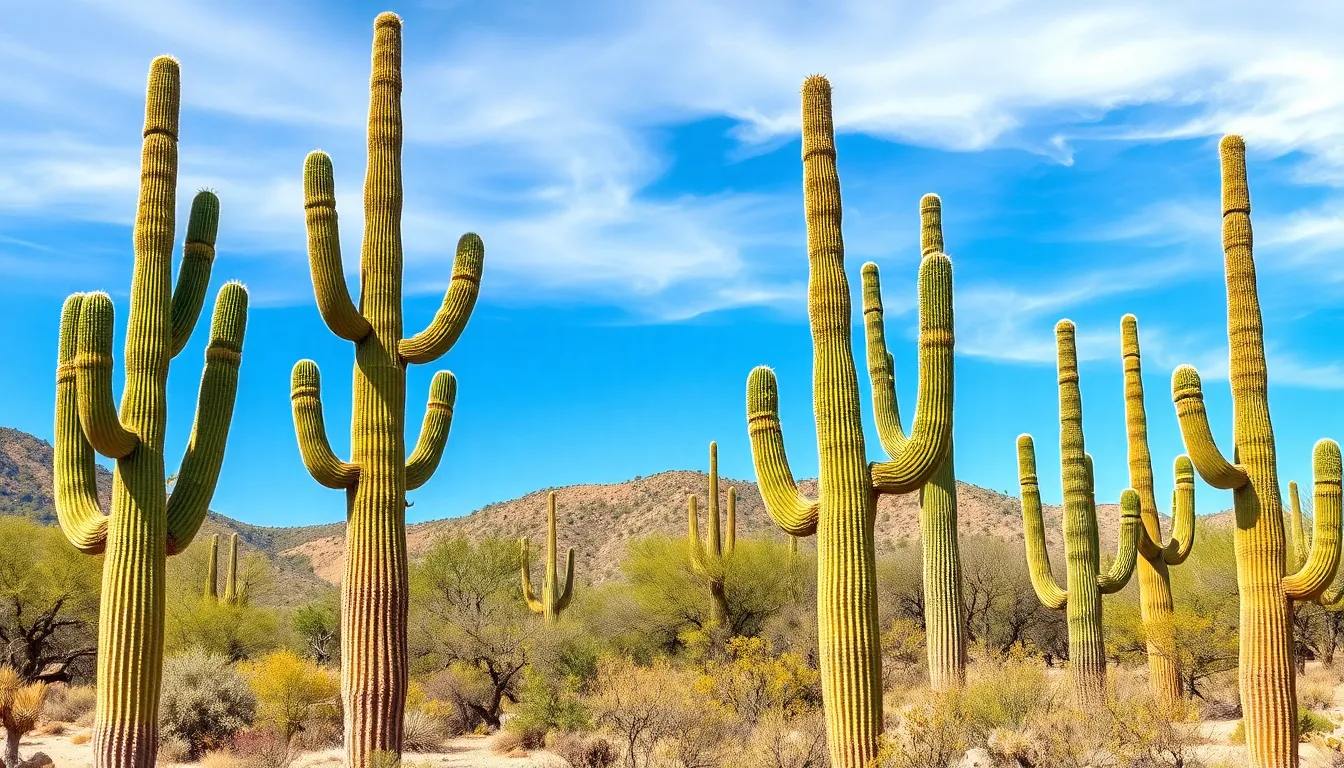
Standing majestically across desert landscapes, columnar cacti represent nature’s most impressive vertical achievements in the plant kingdom. These towering specimens can reach extraordinary heights while showcasing remarkable adaptations that allow them to thrive in harsh desert conditions.
Saguaro Cactus Characteristics
Saguaro cacti dominate the Sonoran Desert with their iconic silhouettes and impressive stature. Native to the southwestern United States and northwestern Mexico, these giants can grow over 40 feet tall and live for more than 150 years. Their thick, waxy skin features many ribs that expand and contract to manage water storage efficiently.
Prominent spines cover the entire surface of these massive cacti, providing protection from herbivores and intense desert sunlight. Large white flowers bloom at night near the crown during late spring and early summer, creating a spectacular display against the desert sky. Arms typically develop after several decades of growth, creating the classic saguaro shape we recognize while providing essential nesting sites for desert birds.
Organ Pipe Cactus Features
Organ Pipe cacti earn their name from their distinctive resemblance to church organ pipes. Multiple thin, tall columns grow from a single base, creating a unique clustered appearance that sets them apart from other columnar species. These Sonoran Desert natives can reach heights of up to 16 feet with their elegant, upright stems.
Fewer ribs distinguish these cacti compared to saguaros, but they compensate with densely packed stout spines covering their surfaces. Large white to cream colored flowers bloom nocturnally, attracting specialized pollinators like bats that navigate the desert darkness. Their growth pattern creates natural wind barriers and provides shelter for smaller desert wildlife.
Cardon Cactus Varieties
Cardon cacti claim the title of largest cactus species by volume and can reach towering heights of up to 60 feet, making them true desert giants. Found mainly in Baja California and northern Mexico, these massive specimens grow more robustly than their saguaro cousins and branch more profusely throughout their lifetime.
Thick, ribbed stems with protective spines characterize these impressive cacti, though their growth patterns create more extensive branching systems. White flowers bloom nocturnally, following the same nighttime schedule as other columnar species to attract nocturnal pollinators. These cacti serve as keystone species in their desert ecosystems, providing vital food sources and shelter for wildlife while supporting overall desert biodiversity through their massive presence.
Globe and Barrel-Shaped Types of Cactus Plants
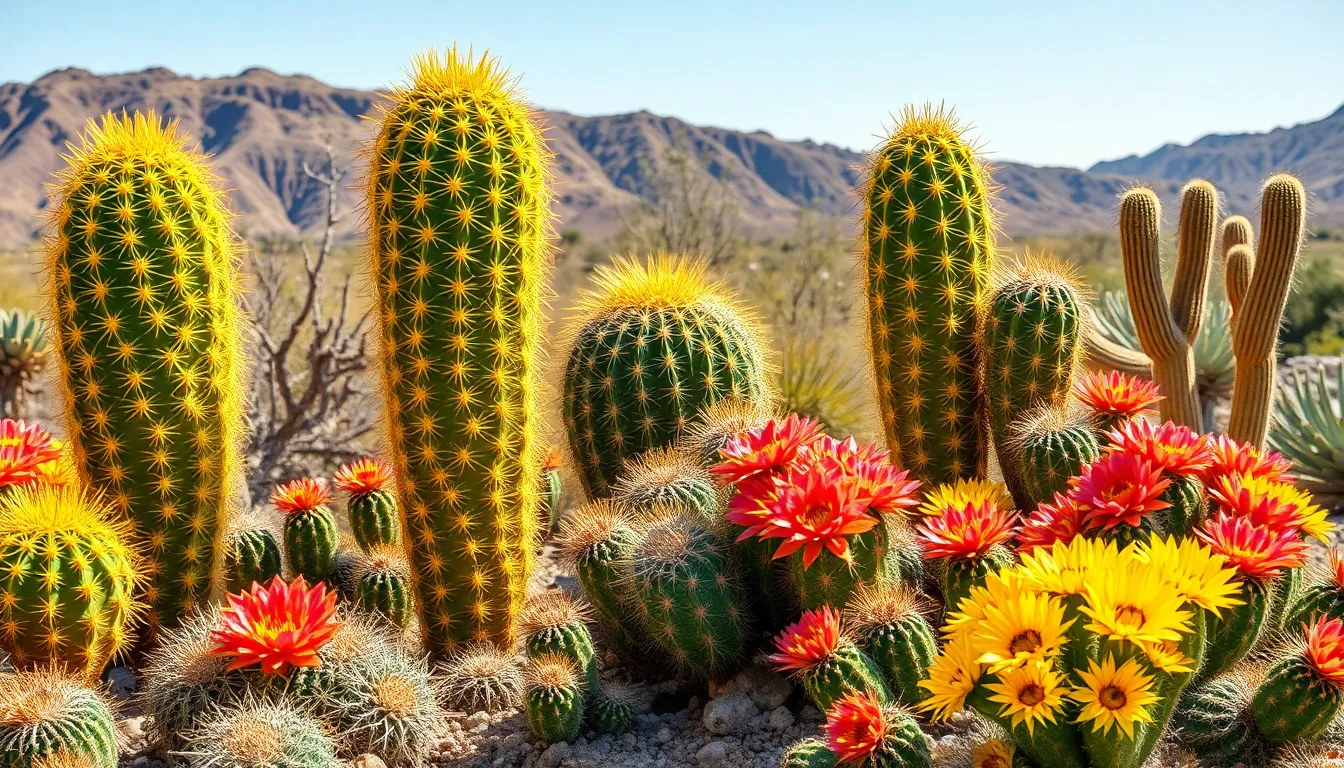
Globe and barrel shaped cacti represent some of the most iconic species in the desert industry. These rounded beauties showcase nature’s engineering prowess through their compact, water storing designs.
Golden Barrel Cactus
Golden barrel cacti (Echinocactus grusonii) stand as classic examples of globe shaped desert plants with their perfectly spherical forms. Dense yellowish spines create a stunning golden appearance that catches sunlight throughout the day. These impressive specimens store massive amounts of water in their thick, fleshy stems to survive prolonged drought periods.
We often recommend golden barrel cacti for beginners because they’re incredibly low maintenance and drought tolerant. Their compact size makes them perfect for container gardening or desert landscaping projects. Mature plants develop a distinctive ribbed pattern that adds architectural interest to any garden space.
Fishhook Barrel Species
Fishhook barrel cacti from the Ferocactus genus feature distinctive curved spines that resemble fishing hooks in their appearance. These robust plants typically grow larger than golden barrels and develop fierce looking spines for protection against herbivores. Their hooked spines create dramatic shadows and visual texture that make them standout specimens.
We’ve observed these barrel cacti varieties can reach over 10 feet in height when given proper growing conditions. Ferocactus species thrive in southwestern U.S. and Mexican desert environments where they’ve adapted to extreme heat and minimal rainfall. Their impressive size and defensive spines make them excellent focal points in xerophytic garden designs.
Hedgehog Cactus Varieties
Hedgehog cacti from the Echinocereus genus offer smaller, more manageable alternatives to barrel shaped species while maintaining similar care requirements. These cylindrical cacti often grow in attractive clusters that spread gradually over time. Vibrant flowers emerge from their spiny crowns during blooming season, creating spectacular color displays.
We appreciate hedgehog varieties for their ornamental appeal and manageable size that works well in smaller garden spaces. Their colorful blooms range from bright pink to deep purple, attracting pollinators like bees and hummingbirds. Native to southwestern U.S. and Mexico, these cacti bring authentic desert beauty to home landscapes without overwhelming smaller areas.
Miniature Cacti: Perfect Types for Indoor Growing
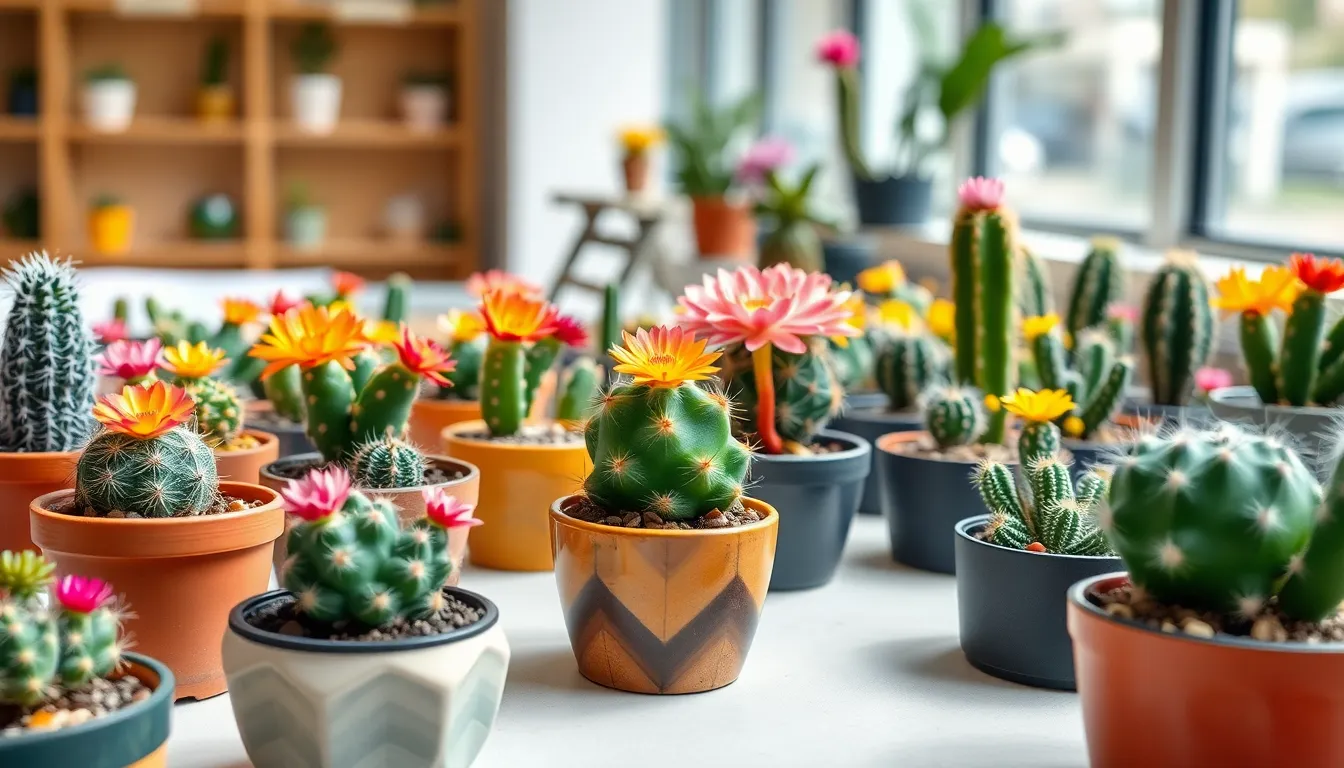
Miniature cacti bring the desert’s beauty indoors with their compact size and low maintenance requirements. These small wonders typically belong to genera with naturally compact growth habits and produce stunning flowers that often seem oversized compared to their petite bodies.
Button Cactus Species
Button cacti feature perfectly rounded, compact shapes that make them ideal for windowsills and small containers. Most button cacti belong to the Mammillaria genus, commonly called pincushion cacti, which includes over 200 species known for their small stature and distinctive tuberculate areoles.
Growth characteristics of button cacti include dense spination patterns and hooked spines that create attractive geometric displays. Many species stay under 4 inches tall, making them perfect for terrariums or small decorative pots. Their nipple-like tubercles arrange in spiral patterns around the stem, creating visual interest even when they’re not blooming.
Flowering patterns in button cacti typically occur in spring and summer, producing small but vibrant blooms in shades of pink, yellow, white, or red. The flowers often form crowns around the top of the plant, creating stunning displays that can last for weeks. Some popular varieties include Mammillaria bocasana (Powder Puff Cactus) and Mammillaria hahniana (Old Lady Cactus).
Star Cactus Varieties
Star cacti display distinctive geometric forms with pronounced ribs that create star-shaped patterns when viewed from above. Astrophytum species dominate this category, featuring 3 to 8 sharp ribs that give these cacti their characteristic architectural appearance.
Visual appeal comes from their striking white flecks or woolly patches scattered across green surfaces, creating unique patterns that vary between species. The Bishop’s Cap (Astrophytum myriostigma) showcases this perfectly with its completely spineless surface covered in white polka dots. These patterns help reflect sunlight and reduce water loss in their natural habitat.
Size specifications for star cacti typically range from 6 to 12 inches in diameter at maturity, with slow growth rates of only 1 to 2 inches per year. Their compact size and architectural beauty make them excellent focal points for indoor cactus collections. Popular varieties include Astrophytum asterias (Sea Urchin Cactus) and Astrophytum ornatum (Monk’s Hood Cactus).
Rebutia Cactus Types
Rebutia cacti form small, globular clusters that produce some of the most spectacular flower displays among miniature cacti. These South American natives typically measure 2 to 4 inches in diameter and create dense mats of colorful blooms that can completely cover the plant body.
Clustering behavior makes Rebutia species particularly attractive as they naturally form groups of small heads from the base of the mother plant. This clustering creates impressive displays over time, with mature colonies producing dozens of individual heads. The small size of each head makes them manageable for indoor spaces while still providing visual impact.
Flower production in Rebutia cacti is legendary among cactus enthusiasts, with blooms that can be larger than the plant body itself. Colors range from bright orange and red to yellow, pink, and purple, often appearing in spring and lasting for several weeks. Species like Rebutia heliosa and Rebutia marsoneri are particularly prized for their prolific blooming habits.
Care requirements for Rebutia cacti include bright indirect light and moderate watering during the growing season, making them perfect for indoor cultivation. They prefer temperatures between 65 to 75°F and need a winter rest period with reduced watering to ensure proper flowering the following spring.
Flowering Cacti: Types That Bloom Spectacularly
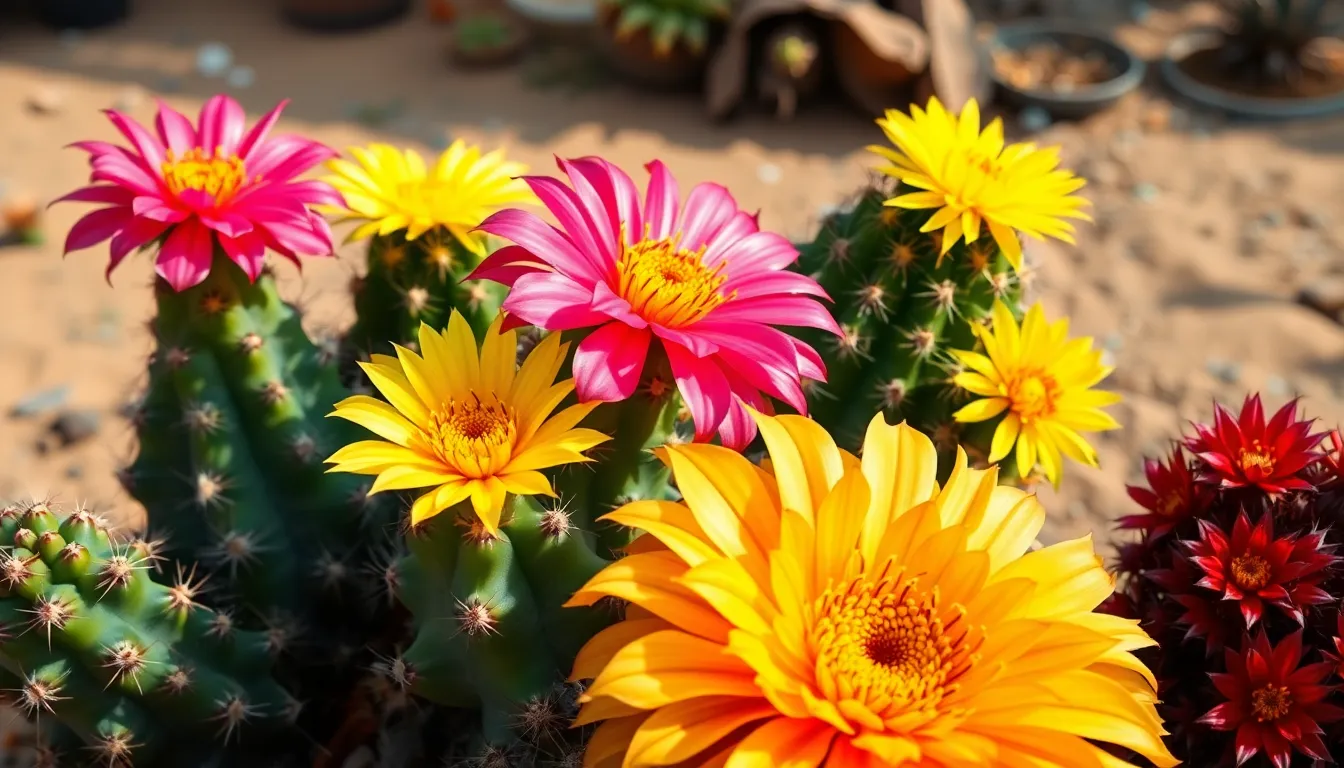
We’re now exploring the most visually stunning cacti varieties that transform from modest desert plants into spectacular flowering displays. These remarkable species prove that cacti aren’t just survival experts but also nature’s most dramatic blooming performers.
Pincushion Cactus Blooms
Pincushion cacti create some of the most charming displays in the cactus industry with their crown-like arrangements of colorful flowers. These small, round cacti produce dense clusters of blooms that form perfect rings around the top of their stems, creating what looks like a floral tiara sitting atop each plant.
Flowers emerge in brilliant pink, sunny yellow, or pristine white colors during spring and summer months. Each bloom measures about half an inch across but appears in groups of 10 to 20 flowers, creating an impressive collective display that can last several weeks.
Care requirements remain minimal as these cacti prefer bright, indirect sunlight and infrequent watering. We recommend allowing the soil to dry completely between waterings, especially during winter dormancy periods when flowering preparation occurs.
Mammillaria Flowering Species
Mammillaria species represent the largest flowering cactus genus with approximately 200 distinct varieties that showcase diverse blooming patterns. These cacti develop distinctive “flower crowns” where small, tubular blooms encircle the plant’s apex in perfectly symmetrical arrangements.
Blooming typically occurs from late winter through early summer, with each species following its own exact timeline. Flowers range from delicate pastels to vibrant jewel tones, and many varieties produce fragrant blossoms that attract pollinators in their native habitats.
Container growing suits these species perfectly since most Mammillaria varieties stay compact, rarely exceeding 6 inches in diameter. We’ve found they thrive in well-draining cactus soil mixes and respond well to monthly feeding during their active growing season.
Echinopsis Cactus Flowers
Echinopsis cacti produce the most dramatic flowering displays among all cactus types, with trumpet-shaped blooms that can measure up to 8 inches across. These spectacular flowers typically open at night and remain open for just 24 to 48 hours, creating fleeting but unforgettable botanical events.
Fragrance accompanies these massive blooms, often filling entire rooms with sweet, intoxicating scents during their brief flowering period. Colors span the spectrum from pure white and soft pink to deep red and vibrant orange, with some varieties producing multiple colors on a single plant.
Night blooming occurs as an adaptation to attract nocturnal pollinators like moths and bats in their natural desert environments. We recommend checking plants in the evening during blooming season since these flowers often open after dark and may close by the following afternoon.
Globular and columnar growth patterns characterize different Echinopsis species, with some forming single spherical stems while others develop tall, cylindrical shapes over time. Both forms produce equally impressive flowers that appear disproportionately large compared to the plant size, making them true showstoppers in any cactus collection.
Edible Types of Cactus Plants
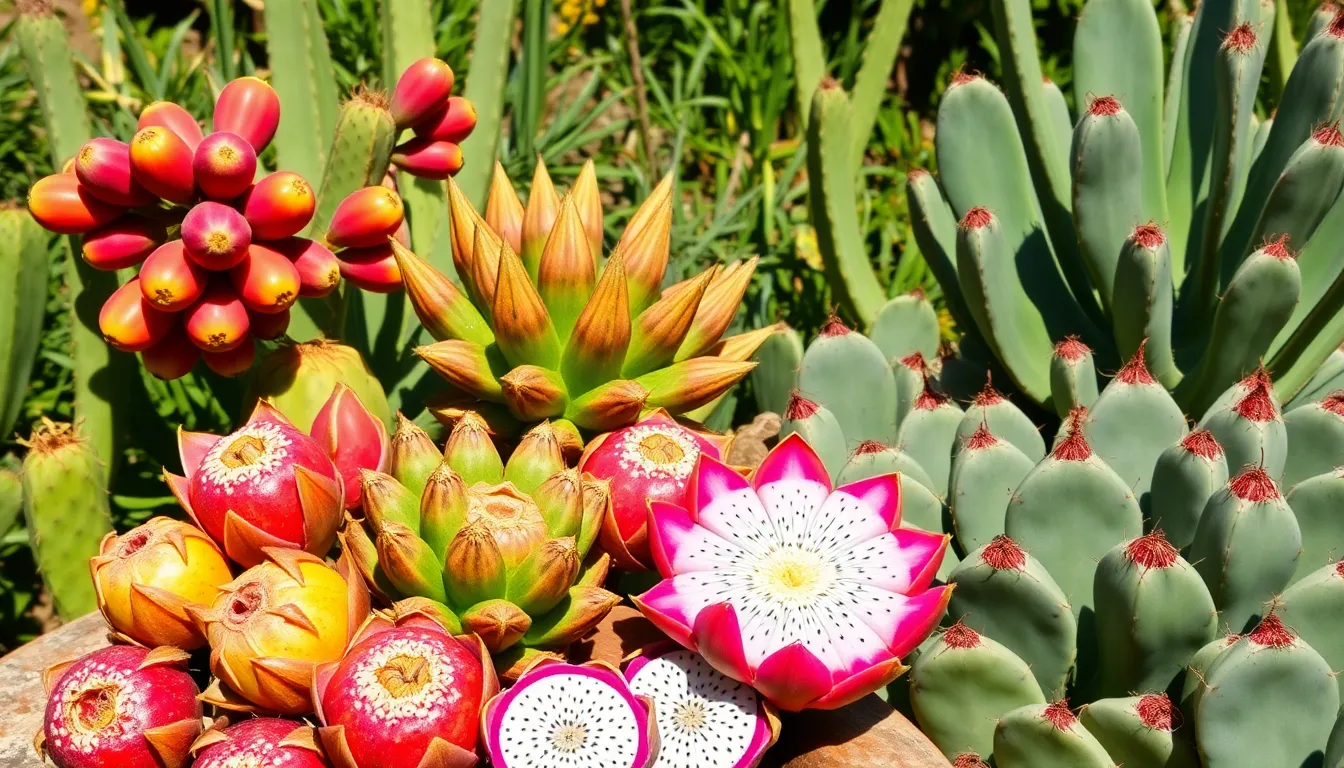
Beyond their ornamental beauty, many cactus varieties offer nutritious and delicious food options that have sustained communities for centuries. We’ll explore the most popular edible cacti that you can grow or find in specialty markets.
Prickly Pear Fruit Varieties
Prickly pear cacti produce both edible pads and colorful fruits that transform your garden into a functional food source. These Opuntia species offer incredible versatility with their flat, rounded pads called “nopales” and vibrant fruits known as “tunas.”
Red tunas deliver the sweetest flavor profile among prickly pear varieties, while purple tunas offer a more complex taste with subtle tartness. Yellow varieties provide milder sweetness that appeals to those new to cactus fruit consumption. Each variety contains high levels of fiber, antioxidants, and essential vitamins that support overall health.
Opuntia ficus-indica stands out as the most extensively cultivated species for commercial food production. This variety produces large, meaty pads perfect for grilling or adding to salads. Fruit production typically occurs during late summer months when colorful tunas ripen to perfection.
Dragon Fruit Cactus
Dragon fruit cactus from the Hylocereus genus creates one of nature’s most visually striking and commercially valuable fruits. These climbing cacti feature large, triangular stems that sprawl across surfaces or climb support structures in tropical environments.
Bright pink skinned varieties with white flesh represent the most common dragon fruit type found in grocery stores. Red fleshed dragons offer deeper flavor complexity with slightly higher antioxidant content. Yellow skinned varieties provide the sweetest taste experience among all dragon fruit types.
Each fruit contains white or red flesh speckled with tiny black seeds that add pleasant texture contrast. Sweet flavor profiles make dragon fruit perfect for fresh consumption, smoothies, or exotic beverage preparations. Commercial cultivation has expanded globally due to increasing demand for this nutritious superfruit.
Nopal Cactus Species
Nopal cactus pads from various Opuntia species serve as nutritious vegetables throughout Mexican cuisine and beyond. Young pads harvested from these cacti provide exceptional nutritional value while offering versatile cooking applications.
Grilled nopales develop a tender texture with slightly tangy flavor that complements meat dishes perfectly. Boiled preparations work well in soups and stews where nopales absorb surrounding flavors. Raw nopales add refreshing crunch to salads while providing maximum nutritional benefits.
Vitamin A content in nopales supports eye health and immune system function effectively. Vitamin C levels exceed those found in many traditional vegetables, while calcium content supports bone health maintenance. Blood sugar regulation studies highlight nopales’ potential benefits for diabetes management, making them valuable additions to health-conscious diets.
Mexican restaurants frequently feature nopales in traditional dishes like tacos, scrambled eggs, and grilled vegetable platters. Home cultivation allows you to harvest young, tender pads throughout the growing season for continuous fresh supply.
Rare and Unusual Cactus Plant Types
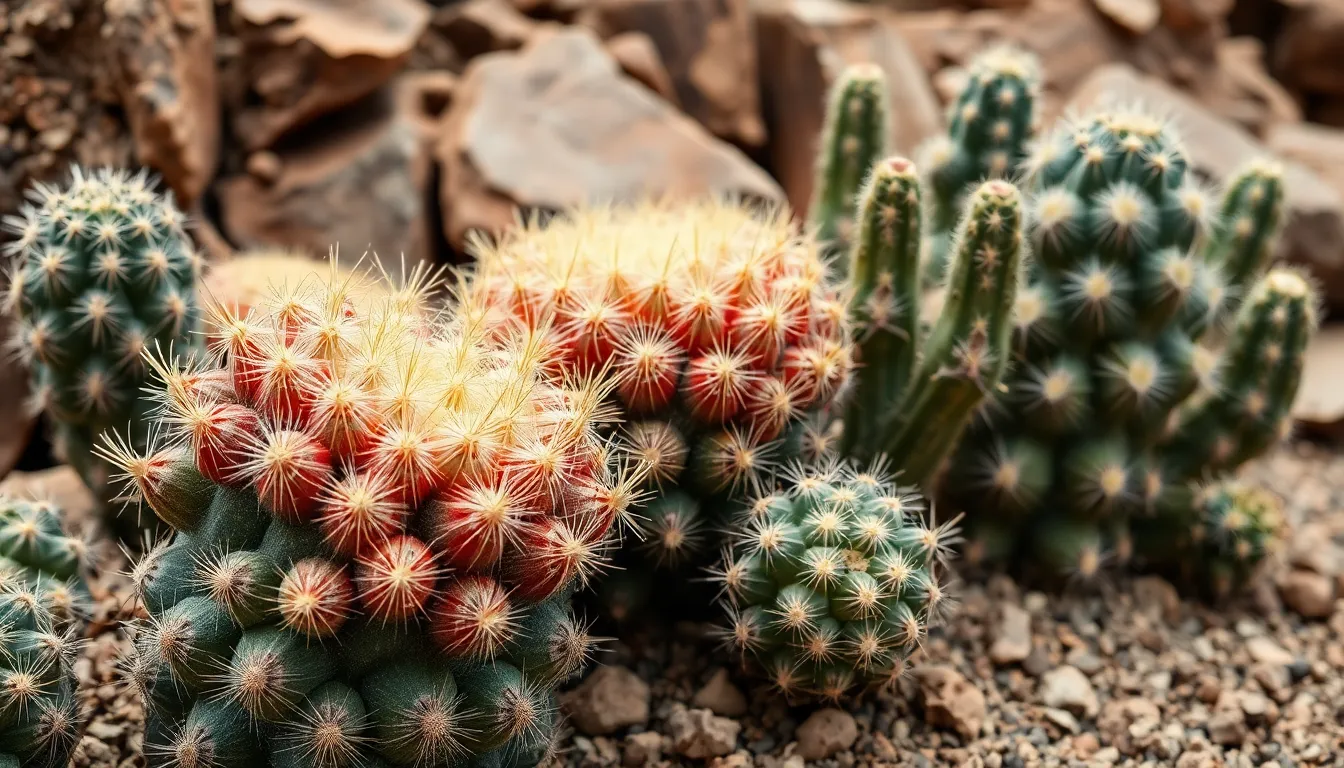
While we’ve explored common cacti varieties, the Cactaceae family includes extraordinary specimens that challenge our typical perception of these desert plants. These unusual varieties showcase nature’s incredible creativity through remarkable adaptations and striking appearances.
Living Rock Cactus
Living Rock Cacti from the Ariocarpus genus represent some of the most fascinating camouflage experts in the plant kingdom. These remarkable specimens grow low and flat against rocky terrain, developing tubercles that perfectly mimic rough stone textures. We find these masters of disguise blending seamlessly into their rocky environments, making them nearly invisible to both predators and casual observers.
Slow growth characterizes these prized specimens, with some varieties taking decades to reach maturity. Collectors highly value these cacti due to their rarity and extraordinary stone like appearance. Survival strategies include their ability to store water in their thick, rock shaped bodies while remaining completely camouflaged from herbivores.
| Living Rock Cactus Facts | Details |
|---|---|
| Growth Rate | Extremely slow, decades to mature |
| Genera | Ariocarpus species |
| Camouflage Ability | Perfect stone mimicry |
| Collector Value | Highly prized and rare |
Old Man Cactus Varieties
Old Man Cacti earn their distinctive name from the long, white, hair like spines that completely cover their cylindrical stems. Cephalocereus senilis and related species showcase this remarkable adaptation where silky white hairs create the appearance of an elderly gentleman’s flowing beard. Protection systems built into these unusual hairs shield the cactus from both intense desert sunlight and surprising frost damage.
Distinctive characteristics set these varieties apart from typical spined cacti through their soft, flowing appearance. We observe how these hair like spines serve multiple protective functions while creating one of nature’s most whimsical looking plants. Growth patterns remain notably slow, making mature specimens particularly valuable to collectors and desert garden enthusiasts.
Brain Cactus Species
Brain Cacti showcase one of the most unusual growth mutations found in the cactus industry through their distinctive crest like formations. Mammillaria elongata ‘Cristata’ and similar varieties develop convoluted, wavy growth patterns that strikingly resemble the folds of a human brain. Genetic mutations in stem growth create these fascinating crested ridges that make each specimen completely unique.
Visual appeal comes from the fuzzy exterior texture combined with small protective spines scattered across the brain like surface. We notice how these crested varieties can produce delicate flowers along their wavy ridges, adding unexpected color to their already dramatic appearance. Growing popularity among collectors stems from their unusual morphology and the fact that no two specimens develop identical crested patterns.
Botanical significance of these rare varieties demonstrates the incredible diversity within the 130 genera and over 1,500 species of the Cactaceae family. Each type represents unique evolutionary adaptations that showcase nature’s ability to create extraordinary survival strategies through camouflage, protection, and specialized growth forms.
Conclusion
The incredible diversity of cactus species offers something extraordinary for every plant enthusiast. Whether you’re drawn to the towering majesty of columnar varieties or the delicate charm of miniature specimens these remarkable plants continue to captivate us with their unique adaptations and stunning beauty.
From desert survivors to forest dwellers and from ornamental showstoppers to edible treasures cacti prove that resilience and beauty can coexist perfectly. We’ve witnessed how these plants have evolved fascinating survival strategies while maintaining their aesthetic appeal.
As you embark on your cactus-growing journey remember that each variety brings its own personality and care requirements. The industry of cacti is vast and rewarding waiting for you to discover your perfect plant companion among these desert gems.
Frequently Asked Questions
How many species of cacti exist in the world?
There are over 2,000 different cactus species worldwide, each with unique characteristics ranging from vibrant flowers to distinctive geometric patterns. This vast diversity makes cacti one of the most varied plant families, offering options for every gardener’s preferences and growing conditions.
What’s the difference between desert cacti and forest cacti?
Desert cacti are adapted to arid environments with thick, waxy skin and water-storing capabilities, while forest cacti thrive in humid, tropical conditions. Forest cacti, like Christmas Cactus, typically have flatter segments and bloom in colorful displays, contrasting with the spiny, drought-resistant desert varieties.
Which cacti are best for beginners?
Golden Barrel Cactus and button cacti from the Mammillaria genus are ideal for beginners due to their low maintenance requirements and resilience. These varieties are forgiving of occasional watering mistakes and adapt well to indoor container growing, making them perfect starter plants.
Can you eat cactus plants?
Yes, several cactus varieties are edible and nutritious. Prickly pear cacti produce edible pads (nopales) and colorful fruits (tunas), while dragon fruit cactus yields sweet, nutritious fruit. Nopal cactus pads are particularly popular in Mexican cuisine for their versatility and health benefits.
What are the largest types of cacti?
Saguaro and Cardon cacti are among the largest species. Saguaro cacti can reach impressive heights and are symbols of the Sonoran Desert, while Cardon cacti are the largest by volume, growing up to 60 feet tall and playing crucial ecosystem roles.
Which cacti produce the most beautiful flowers?
Echinopsis cacti produce dramatic trumpet-shaped flowers that bloom at night, while Epiphyllum species are celebrated for large, colorful blooms. Pincushion and Mammillaria cacti create charming “flower crowns,” and Night-Blooming Cereus produces fragrant flowers that open only at night.
What makes some cacti rare and collectible?
Rare cacti like Living Rock Cactus are prized for unique characteristics such as remarkable camouflage and extremely slow growth. Old Man Cactus features distinctive white, hair-like spines, while Brain Cactus displays unusual crested growth patterns resembling brain folds, making them highly sought after by collectors.
Are there cacti suitable for indoor growing?
Miniature cacti, including button cacti, star cacti, and Rebutia species, are perfect for indoor cultivation. These compact varieties require minimal maintenance, adapt well to container growing, and many produce spectacular flower displays, making them ideal houseplants for cactus enthusiasts.



